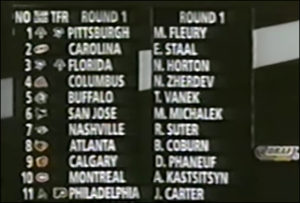The Unfortunate Reality of the 2017 Draft
In a little over three months, the hockey world will focus on Chicago for the 2017 NHL Entry Draft.
Draft Day is usually an eagerly-awaited event, when talented young players take their first steps toward pro careers. It is usually a time great excitement, as each club and its fans dream of the possibilities that come with new faces.
In other words, Draft Day is usually very special and worth its year-long wait.
But this year? Not so much.
Three months out, the hockey world should already realize that 2017 is not a strong draft year. In fact, it has all the signs of a classic weak one.
What factors make for an obviously strong or weak draft year? Consider these definitions:

This was the start of a strong draft year.
1. In a strong draft year, each team can reasonably expect to get a future NHL regular in the first round, and at least half the teams can expect to land a future All-Star. It is also clear that the second and third rounds will produce some gems that go to the teams with the best scouting staffs. In other words, a strong draft year is deep in talent, and this usually become evident by the time these players are 16-year-olds.
2. In a weak draft year, as many as half the teams picking in the first round can’t expect to get a future NHL regular, and only a handful (up to three or four) come away thinking they have a future All-Star. The second and third rounds both appear wide open with few or no potential gems. Thus, there is no real separation between players available late in the first round and those available in the third, and none of these players are guaranteed to play in the NHL. This is also evident by the time these players turn 16.
There have been many strong draft years of late, but let’s look back to 2003, one of the strongest ever. All 30 first-rounders reached the NHL, a group that included Marc-Andre Fleury, Eric Staal, Thomas Vanek, Ryan Suter, Dion Phaneuf, Jeff Carter, Dustin Brown, Zach Parise, Ryan Getlzaf, Corey Perry. That list goes on and on. Even the second round produced gems in Patrice Bergeron, Shea Weber, and David Backes.
Scouts who assessed the 2003 draft class understood this was a special group at least two years before Draft Day.
On the other hand, four years before the 2003 draft, the hockey world had to endure the painfully weak year that was 1999. Only two stars, Daniel and Henrik Sedin, came out of that first round, and they were only really available as a package deal. The vast majority of 1999 first-round picks, including No. 1 overall Patrik Stefan, are long forgotten. Three first-rounders never played a single NHL game, and there were no legitimate second- or third-round gems.
I was working at a sports website in 1999, covering that draft. I sensed something was wrong when I found myself hyping players like Branislav Mezei, Scott Kelman, and David Tanabe. I didn’t want to admit it at the time, but I knew I was dealing with a weak pool –something NHL scouts had known for years. Even players who were supposed to be good, like Pavel Brendl and Oleg Saprykin, were mediocre at best.
Is it a coincidence that players born during that forgettable draft year already look like a weak group overall? Maybe so, and maybe the future will prove me wrong, but it is hard to get up for the 2017 draft in much the same way it was hard to get excited about 1999.

Nolan Patrick (left) and Nico Hischier are talented players who will play in the NHL, but they don’t represent the level of top-two talent you would see in a strong draft year.
At the very top end of this year’s draft are players who would be considered lower first-round picks in most other years, and the league will be lucky if half of the top 30 players go on to have substantial NHL careers. Even the heavily-hyped players in the mix for No. 1 overall, Nolan Patrick and Nico Hischier, are far from can’t miss stars. Of the two, Patrick is the safer pick, while Hischier has greater upside. Still, it’s a reach to say either one of them is a future superstar or could change the fate of an NHL franchise.
If I had to pick one, I’d gamble and take Hischier, but this is hardly a choice between Connor McDavid and Jack Eichel or Auston Matthews and Patrik Laine. So there isn’t much reason to be counting the days until June. In a good draft year, nobody has to qualify their excitement like this. In a bad draft year, it’s the only way to keep your sanity. Swallow the medicine of 2017 and move on to 2018.
And that’s the silver lining here. Next year will be worth the wait for its very deep talent pool, because those 2018 players, most of whom are still 16, are miles ahead of where the 2017 crop was a year ago.
